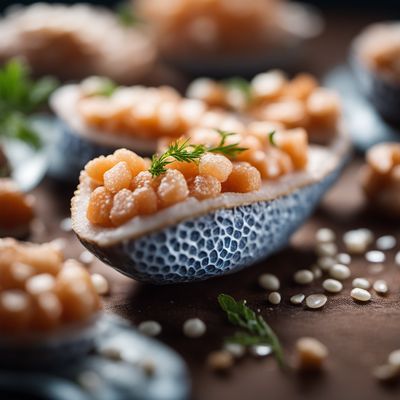
Ingredient
Capelin
The Tiny Fish with Big Flavor: Exploring the Delights of Capelin
Capelin is a small, silvery fish with a delicate texture and a rich, oily flavor. It has a slender body, measuring around 15 centimeters in length, and is known for its distinctive taste that is often described as buttery and slightly salty. The flesh of capelin is tender and flakes easily, making it a popular choice for various cooking methods such as grilling, frying, or pickling. Its silver skin adds a touch of elegance to any dish, and its small size makes it perfect for appetizers or as a garnish.
Origins and history
Capelin is native to the North Atlantic Ocean and is particularly abundant in the waters surrounding Iceland, Greenland, and Newfoundland. It has been a staple in the diet of indigenous communities in these regions for centuries. Capelin also plays a significant role in the ecosystem as it serves as a vital food source for larger fish, seabirds, and marine mammals. In Iceland, capelin has a cultural significance and is celebrated during the annual Capelin Festival, where locals gather to enjoy the fish and participate in various festivities.
Nutritional information
Capelin is a nutritional powerhouse, packed with omega-3 fatty acids, protein, and essential minerals such as calcium, iron, and phosphorus. A 100-gram serving of capelin provides approximately 140 calories, making it a healthy choice for those looking to incorporate nutrient-dense foods into their diet.
Allergens
Capelin may contain allergens such as fish proteins and should be avoided by individuals with fish allergies.
How to select
When selecting capelin, look for fish that have clear, bright eyes, shiny skin, and a fresh, oceanic smell. The flesh should be firm to the touch and free from any discoloration or strong odor. If purchasing capelin fillets, ensure they are moist and have no signs of drying or browning.
Storage recommendations
To maintain the freshness of capelin, it is best to store it in a refrigerator at a temperature of 32°F to 38°F (0°C to 3°C). If purchased whole, it is advisable to clean and gut the fish before storing. Capelin can be kept for up to two days in the refrigerator, but for longer-term storage, it is recommended to freeze the fish. When freezing, ensure the fish is properly wrapped or sealed to prevent freezer burn.
How to produce
Capelin is primarily caught in the wild and is not commonly produced through aquaculture or farming. Therefore, it is not feasible for amateurs to grow or raise capelin.
Preparation tips
Capelin can be prepared in various ways, including grilling, frying, baking, or pickling. To grill capelin, marinate the fish in a mixture of olive oil, lemon juice, garlic, and herbs, then cook over medium heat for a few minutes on each side until the flesh is opaque and flakes easily. When frying capelin, coat the fish in a light batter or breadcrumbs and fry until golden brown and crispy. Capelin can also be baked whole or stuffed with herbs and spices for a flavorful and elegant dish. For pickling, combine vinegar, sugar, and spices in a saucepan, bring to a boil, and pour over cleaned capelin. Allow the fish to marinate in the refrigerator for a few days before enjoying.
Culinary uses
Capelin is commonly used in various cuisines around the world. It can be enjoyed as a standalone dish, served with a squeeze of lemon and a sprinkle of sea salt, or incorporated into salads, pasta dishes, or sushi rolls. Capelin roe, known as masago, is a popular ingredient in sushi and adds a burst of flavor and texture. The small size of capelin makes it ideal for appetizers, canapés, or as a garnish for seafood platters.
Availability
Capelin is commonly available in countries such as Iceland, Greenland, and Canada, where it is harvested from the surrounding waters. It may also be found in specialty seafood markets or online retailers that offer a wide range of fresh and frozen seafood products.
More ingredients from this category » Browse all

Horse jack
Equine Delicacy

Amberjack
The Versatile Ocean Delight

Cobia
The Versatile Fish: Cobia

Barracudas
The Fierce Predator of the Sea

Pomfret, Indo-Pacific
The Ocean's Delicacy

Butterfish
"The Delicate Delight: Unveiling the Secrets of Butterfish"

Dolphinfishes
The Versatile Delight

Bluefish
"The Bold and Flavorful Bluefish: A Seafood Delight"

Mackerels, jack and horse mackerel, scads
The Flavorful and Nutrient-Rich Catch

Garfish
The Sleek and Versatile Garfish

Pompanos
The Versatile Delicacy: Pompanos

Pomfret, atlantic
The Ocean's Delicacy: Atlantic Pomfret
